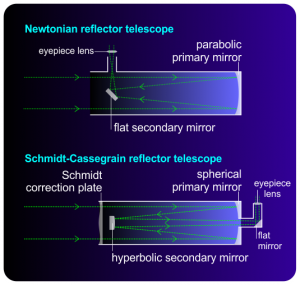
Newtonian Telescopes
The first reflecting telescope was designed and constructed by Sir Isaac Newton in 1668. Newton’s telescope was revolutionary in its design, since it was the first to successfully use a concave mirror, instead of lenses, to bring light to a focus.
However, Newton was not the first to suggest using mirrors instead of lenses in telescope design. Gallileo had suggested the idea when he began using his refracting telescope in 1609, and the concept may even date back further than this. However, Newton was the first to construct a working reflecting (or reflector) telescope.
Small Newtonian telescopes usually consist of a large, parabolic, primary mirror set at one end of a tube. This reflects the light onto a smaller, flat mirror, set in front of the primary mirror, near to the aperture at the open end of the telescope’s tube. This flat mirror is set a 45 degree angle to the primary mirror, diverting the light through a small hole in the side of tube of the telescope to an eyepiece.
The eyepiece is positioned at the focal point of the primary mirror and is usually made from two small converging lenses. The position of the eyepiece can be moved slightly, inwards and outwards, relative to the side of the tube, in order to focus the telescope.
Since the secondary mirror is so close to the primary mirror, relative to the distant objects that the telescope is focused on, the secondary mirror is not visible when looking through the telescope, even though it is placed directly in the path of the light between the primary mirror and the eyepiece. However, the secondary mirror does reduce the effective size of the telescope’s aperture, leading to some reduction in the resolution and brightness of the image produced.
Diffraction spikes can also be caused by the struts, or vanes, attaching the secondary mirror to the tube of the telescope. This can lead to distortions in the shape of bright stars, often making them appear like a four or six-pointed “star” in astrophotography, rather than singular, round, point sources of light. This problem can be avoided by using an arch-shaped support, instead of a radial three or four-vane “spider” support, although the effect can actually be quite beautiful.
The Newtonian telescope’s design is highly scalable, and most of the world’s largest telescopes still use the same basic configuration of mirrors, although usually without a tube.
Reflecting telescopes also have the advantage over refracting telescopes that they do not suffer from the problem of chromatic aberration. This effect can produce rainbow-coloured bands around images viewed through lenses, similar to those seen when looking through a prism. This is due to the fact that lenses refract different wavelengths (i.e. colours) of light by different amounts.
Cassegrain Telescopes
A Cassegrain telescope is similar in its design to a Newtonian telescope, using a parabolic primary mirror. However, instead of the secondary, flat mirror diverting the light at right angles through a hole in the side of the tube, the secondary mirror is hyperbolic (convex) in shape and reflects the light straight back down the tube towards the primary mirror. A small hole is cut into the centre of the primary mirror, allowing the light to pass through to an eyepiece at the bottom of the telescope.
The secondary mirror is usually hyperbolic to allow it to be placed higher up the telescope’s tube, allowing it to be smaller, so that it obscures less of the primary mirror than it would need to if it was flat.
The Cassegrain design is named after Laurent Cassegrain, who is attributed with publishing the design in 1672.
In asymmetric Cassegrain telescopes, the two mirrors are set at small angles to each other, in order to avoid the secondary mirror obscuring the primary, or to avoid the necessity for the hole in the primary mirror.
One advantage of the Cassegrain design is that a shorter tube is generally needed than with a Newtonian telescope. This is because the eyepiece must be placed close to the focal point of the primary mirror. Since the light travels twice the distance from the primary to the secondary mirror, before reaching the eyepiece in the Cassegrain design, the telescope’s tube can be shorter than that of a Newtonian telescope with a similarly curved primary mirror.
Newtonian telescopes are often quite unwieldy when used with an equatorial mount, since the eyepiece can end up pointing in awkward directions. Since Cassegrain telescopes have the eyepiece set at the bottom of the tube, this is not usually so much of a problem.
Schmidt-Cassegrain Telescopes
A Schmidt-Cassegrain telescope uses a combination of the Cassegrain telescope’s mirror configuration with a Schmidt correction plate. This is a transparent disc placed over the end of the telescope’s tube. The disc is of a particular shape that allows it to correct for spherical aberration, meaning that a spherical, concave, primary mirror can be used instead of a parabolic mirror.
Spherical mirror are generally much easier to manufacturer than parabolic mirrors. Schmidt-Cassegrain telescopes are, therefore, both compact in size and cheap to produce, making them ideal for the mass market.